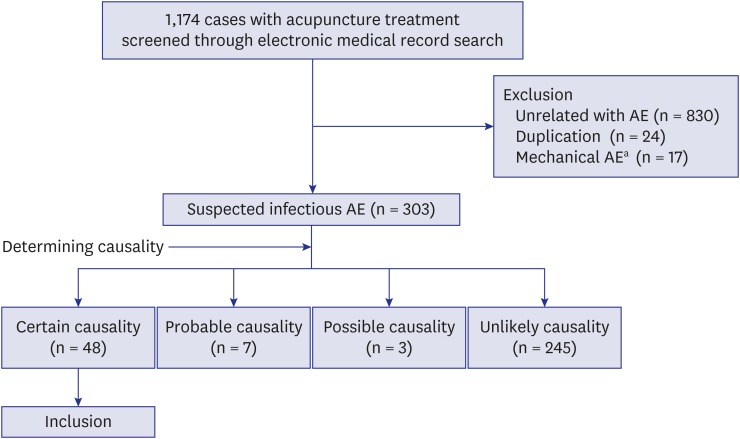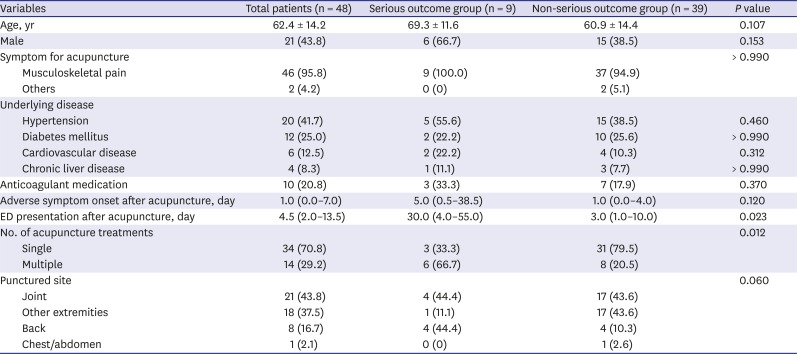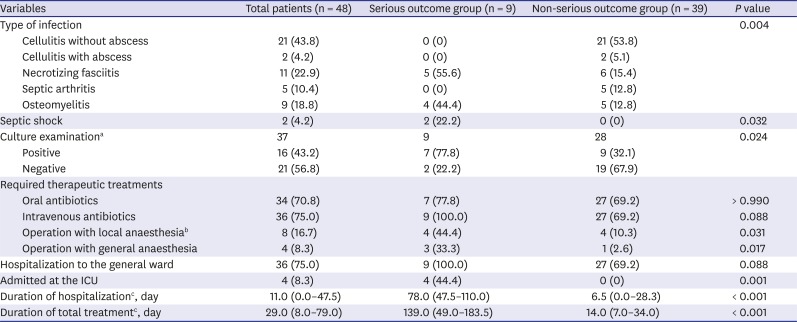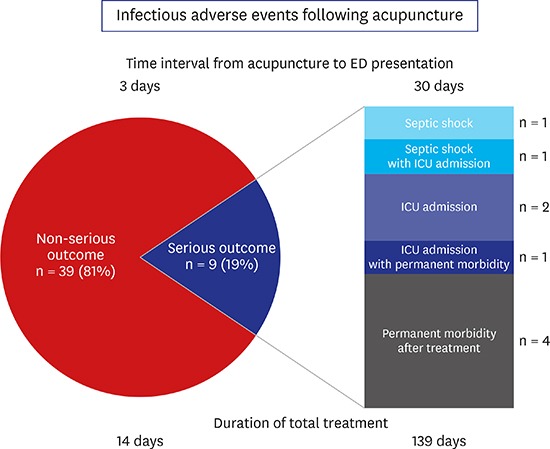1. Park SM, Kim WJ, Mun JH, Kim HS, Ko HC, Kim BS, et al. Adverse events associated with acupuncture: a clinicopathologic review. Int J Dermatol. 2016; 55(7):757–763. PMID:
26341956.
2. Woo PC, Lau SK, Wong SS, Yuen KY.
Staphylococcus aureus subcutaneous abscess complicating acupuncture: need for implementation of proper infection control guidelines. New Microbiol. 2003; 26(2):169–174. PMID:
12737199.
3. Clean Needle Technique Manual: Best Practices for Acupuncture Needle Safety and Related Procedures. 7th ed. Baltimore, MD: Council of Colleges of Acupuncture and Oriental Medicine;2015.
4. Ernst G, Strzyz H, Hagmeister H. Incidence of adverse effects during acupuncture therapy-a multicentre survey. Complement Ther Med. 2003; 11(2):93–97. PMID:
12801494.
5. Lao L, Hamilton GR, Fu J, Berman BM. Is acupuncture safe? A systematic review of case reports. Altern Ther Health Med. 2003; 9(1):72–83. PMID:
12564354.
6. Witt CM, Pach D, Brinkhaus B, Wruck K, Tag B, Mank S, et al. Safety of acupuncture: results of a prospective observational study with 229,230 patients and introduction of a medical information and consent form. Forsch Komplement Med. 2009; 16(2):91–97.
7. Ernst E. Deaths after acupuncture: a systematic review. Int J Risk Saf Med. 2010; 22(3):131–136.
8. Tang P, Walsh S, Murray C, Alterman C, Varia M, Broukhanski G, et al. Outbreak of acupuncture-associated cutaneous
Mycobacterium abscessus infections. J Cutan Med Surg. 2006; 10(4):166–169. PMID:
17234114.
9. Lee HJ, Kim YJ, Kim WY. Safety concerns with thoracoabdominal acupuncture: experience at a tertiary-care emergency department. Pain Med. 2017; 18(12):2504–2508. PMID:
28431130.
10. Kee SJ, Suh SP. Increasing burden of nontuberculous mycobacteria in Korea. J Korean Med Sci. 2017; 32(8):1215–1216. PMID:
28665053.
11. Xu S, Wang L, Cooper E, Zhang M, Manheimer E, Berman B, et al. Adverse events of acupuncture: a systematic review of case reports. Evid Based Complement Alternat Med. 2013; 2013:581203. PMID:
23573135.
13. World Health Organization. Guidelines on Basic Training and Safety in Acupuncture. Geneva, Switzerland: World Health Organization;1999.
14. Kim MR, Shin JS, Lee J, Lee YJ, Ahn YJ, Park KB, et al. Safety of acupuncture and pharmacopuncture in 80,523 musculoskeletal disorder patients: a retrospective review of internal safety inspection and electronic medical records. Medicine (Baltimore). 2016; 95(18):e3635. PMID:
27149503.
15. White A, Hayhoe S, Hart A, Ernst E. Adverse events following acupuncture: prospective survey of 32,000 consultations with doctors and physiotherapists. BMJ. 2001; 323(7311):485–486. PMID:
11532840.
16. Woo PC, Leung KW, Wong SS, Chong KT, Cheung EY, Yuen KY. Relatively alcohol-resistant mycobacteria are emerging pathogens in patients receiving acupuncture treatment. J Clin Microbiol. 2002; 40(4):1219–1224. PMID:
11923335.
17. Song JY, Sohn JW, Jeong HW, Cheong HJ, Kim WJ, Kim MJ. An outbreak of post-acupuncture cutaneous infection due to
Mycobacterium abscessus. BMC Infect Dis. 2006; 6(1):6. PMID:
16412228.
18. Koh SJ, Song T, Kang YA, Choi JW, Chang KJ, Chu CS, et al. An outbreak of skin and soft tissue infection caused by
Mycobacterium abscessus following acupuncture. Clin Microbiol Infect. 2010; 16(7):895–901. PMID:
19694761.
19. Ruef C. Complicated skin and soft-tissue infections--consider gram-negative pathogens. Infection. 2008; 36(4):295. PMID:
18663409.
20. Bang MS, Lim SH. Paraplegia caused by spinal infection after acupuncture. Spinal Cord. 2006; 44(4):258–259. PMID:
16151454.
21. Woo PC, Li JH, Tang W, Yuen K. Acupuncture mycobacteriosis. N Engl J Med. 2001; 345(11):842–843. PMID:
11556317.








 PDF
PDF Citation
Citation Print
Print




 XML Download
XML Download